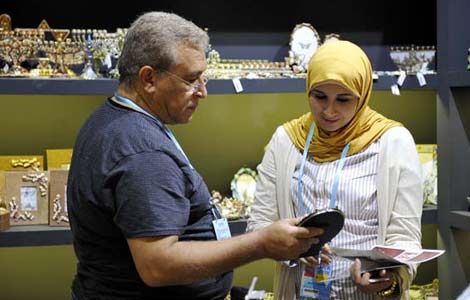
|
Li Songshan and his wife, Han Rong, began their African art collection after becoming interested in woodcarvings. Meng Jing / China Daily |
While their peers enjoy a quiet retirement, Li Songshan and Han Rong are building an African culture center inspired by a lifetime in Tanzania collecting Makonde carvings
'It was like marrying off our own daughter. It was hard but you still want her to end up with someone good, someone who deserves her."
Li Songshan is talking about 12,000 pieces of African art that he and his wife Han Rong spent more than 30 years collecting before handing them over to a museum in northern China so that others could enjoy the art they cherish.
But the story of Li, 71, and Han, 68, is more than one about an appreciation for art; it is also one about a long and abiding love of Africa, a relationship that began about 50 years ago.
That relationship will soon bring the realization of a long-held dream for the retired couple when an African culture center that they are having built opens in Songzhuang, about 30 kilometers from the center of Beijing.
African Tribe, with 13 buildings covering 1,000 square meters, will be the first privately owned non-profit organization in China dedicated to promoting African culture.
The couple, who owned a business in southern Tanzania before returning to China in 2008, spent many years in Africa and say it is a continent full of treasures, not only because of its natural resources but also because of its culture and arts.
The couple's African connection began in the late 1960s, when they were chosen by China's central government to study Swahili in an effort to strengthen ties with developing countries in Africa.
"At that time, professional Swahili speakers in China were no more than 200 and learning the language was seen as an important way to improve communication," Li says. "Though we knew nothing about the language, we all felt it was a privilege to be the chosen ones."
For Li and a dozen or so of his classmates there were only two tasks: "One was to master the language, no one could fail. The other was to work in Africa, no one could be an exception," he says.
After two years studying Swahili and another three translating Chinese literature into it and compiling the first Chinese-Swahili dictionary, Li was sent to Tanzania in the late 1970s to work first as an interpreter and then as a representative of the Ministry of Culture when his wife Han joined him in the 1980s.
The job drew the couple's attention to African culture, Makonde woodcarvings in particular. "For many foreigners, Makonde woodcarvings are no more than souvenirs, but for us, they are indeed artists' creative expressions for worshiping their ancestors," Li says.
Speaking the local language also allowed them to communicate with artists without boundaries. "The more we understand the history and tradition of the art, the individual stories of each piece, the more we are interested in the artwork," Han says.
Their interest soon developed into a collection, with the couple spending most of their leisure time visiting markets in the hope of finding new carvings. Before the Chinese government recalled them to China in the late 1980s the pair had collected hundreds of Makonde sculptures.
Back in China, they found Swahili was no longer as useful as it had been. The Chinese government had begun to concentrate on English, even when dealing with Africa.
There seemed only two options left for Li and Han. They could either stay in China and forget about their former lives or leave China and continue their adventure in Africa. For a couple who had spent half of their lives studying Swahili and working in the continent, it was not a difficult decision.
With all their savings - about $4,000 (3,079 euros) - they boarded a plane to Tanzania in 1990.
"We were very persistent and determined to work in culture-related areas again, which later proved to be a big challenge," Han says, adding that after renting an apartment, buying a car and registering a company, they had almost no money left within half a year.
Things started to turn around the following year when a Shanghai-based company asked for local help to sell 3,000 bicycles in Tanzania. There was huge demand for bicycles but no buyers in the country could pay the bicycle producers in dollars because foreign exchange was in even higher demand than bicycles.
Securing enough dollars was the key to landing the deal. For almost a month, Li and Han wandered outside a local bank in order to find the manager who was in charge of currency exchange.
"We often skipped lunch so that we could get a chance to talk to the guy. In the end, he gave us a quota of as much as $130,000, which was a huge amount of money at that time," Han says.
With close ties to Chinese businesses and strong local demand for Chinese exports, the couple gradually grew into the largest traders in Tanzania and as their wealth grew, so too did their collection of Makonde woodcarvings.
In 1994 they bought the largest wood production factory in southern Tanzania and, with a license to cut trees, became the only carving collectors in the country able to provide raw materials for the artists.
Their passion for woodcarving pushed them to found the Tanzania National Woodcarving Association and the strong connections they had developed while gathering their collection helped them convince 100 top Makonde artisans to work in the organization.
"Many of the artists had never had the chance to work on large pieces of Blackwood because they could not afford big sized materials," Han says. "Not only were we able to provide them with top quality materials but we also guaranteed to buy their work, so that they didn't need to worry about making a living."
Through the association Makonde artists were able to create some of their most satisfactory work, Han says.
In 2008 Li and Han packed their collection into four containers and shipped it to China. Many of the Makonde artists they had met had expressed an interest seeing their art better recognized and understood internationally, and the couple hoped to do that in their native land.
They originally planned to open their own museum to exhibit the collection, but abandoned the idea in favor of giving 12,000 pieces, almost their entire collection, to a museum in Changchun, in Northeast China's Jilin province.
The museum, which bears their name, opened to the public in 2011 as the first museum in China focused on foreign artwork.
"The public museum can maintain the pieces better and the collection will have much bigger influence on visitors there."
Although the couple have little of their collection left, they want their new project, African Tribe, to be another source of bringing African culture to China. Construction will not be finished until May, but they already have plenty of plans for it.
"As the first generation of Chinese workers in Africa, we want people to know that Africa has more than rich natural resources," Han says. "We hope the splendid culture and art there can attract more Chinese youngsters to spend their life in Africa, like we did decades ago."
Li says: "There will be an auditorium for experts on African studies to give speeches, a library full of Africa-related books, a movie theater to show African movies and a restaurant featuring African-style dishes." He jokes that their investment in the center may cost the last penny of his family fortune.
"Families and friends think we are out of our minds every time we make major decisions like this. But, life is not about what you have but what you can give. To foster more Chinese interest in the culture and art of that beautiful land is the best thing we can give."








